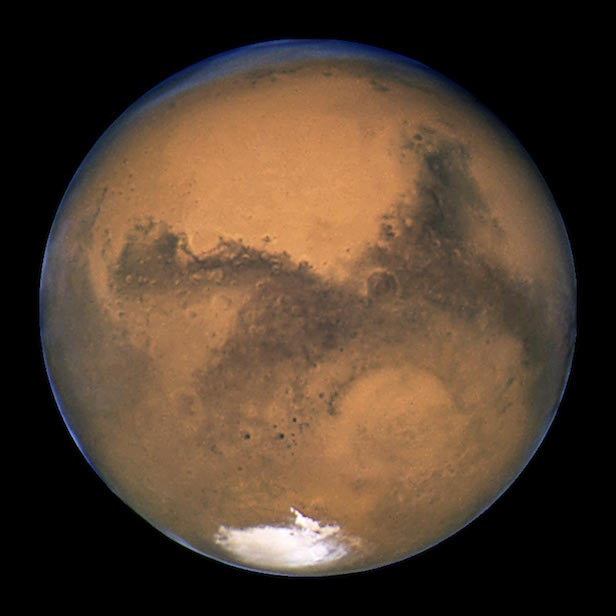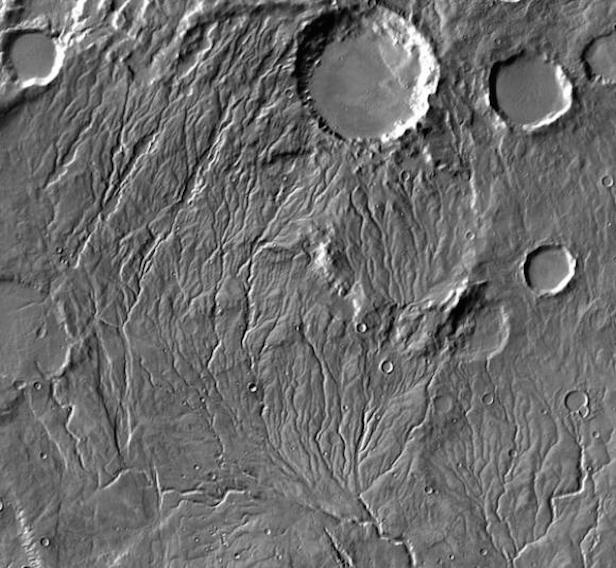Liquid water could have flowed on a cold and icy Mars
New research shows it was possible for liquid water to reshape the undeveloped and glacial Martian surface

Due to the low energy output from the Sun in the early Solar System, it is thought Mars was a much colder and icier planet. Image credit: NASA/ESA/The Hubble Heritage Team (STScI/AURA)
Planetary scientists at Brown University have conducted research supporting the idea that periodic melting of ice sheets on the Martian surface could have created ancient valleys and lakebeds. They state that despite early Mars being ‘cold and icy’, ice could have melted during peak summertime, shaping the landscape to create the elusive valleys and lakebeds we see on the planet now.
Mars’ surface has baffled astronomers for a long time, as it’s currently geology indicates that a ‘warm and wet’ scenario occurred at some point, but atmospheric models suggest that there was also a ‘cold and icy’ point early in its life. This study has shown that it is plausible for both to occur, even if Mars was generally frozen over. This is because during peak summertime, the temperature in the southern hemisphere would rise slightly above freezing, causing some melting in the edges of glaciers. The result of this would cause small amounts of water to materialise annually, thus carving out the features we see today.
“We see this in the Antarctic Dry Valleys, where seasonal temperature variation is sufficient to form and sustain lakes even though mean annual temperature is well below freezing,” says Ashley Palumbo, a PhD student at Brown University. “We wanted to see if something similar might be possible for ancient Mars.”
To come to these conclusions, the scientists began with a state-of-the-art climate model for Mars, which included many constraints for an ancient atmosphere composed largely of carbon dioxide (similar to recent atmosphere). This model showed a cold and icy early Mars, mostly because it is generally thought that the Sun’s energy output was more deficient then compared to the present. This model was also run with broad parameter of variables that could have potentially affected the outcome 4 billion years ago, which was when the valley’s networks in the southern highlands were formed.

The valley network and lakebeds strongly suggests that Mars was once a much hotter and wetter place, but this new study shows it doesn’t have to be warm to be wet. Image credit: NASA/JPL-Caltech/Arizona State University
There were multiple factors to consider in this model, as the slightest change in any condition could drastically alter the outcome. Firstly, Scientists can typically agree that the Martian atmosphere was thicker in the past and that it was mostly comprised of carbon dioxide, but it is not clear how much thicker it was or if there were traces of other greenhouse gases present at the time. Then there was the issue with Mars’ orbit, as scientists had to consider what its orbit was like 4 billion years ago. This included considering the axis tilt and the eccentricity of its orbit, as the seasonal changes would vastly affect the surface temperatures.
The results from this showed that it is indeed possible for the temperature to reach above freezing on a young Martian surface, consequently leading to enough water melting to carve the surface accordingly. Palumbo states that these results offer uniting evidence for the presence of liquid, flowing water on Mars, as well as atmospheric evidence for a young, cold, icy Mars.
“This work adds a plausible hypothesis to explain the way in which liquid water could have formed on early Mars, in a manner similar to the seasonal melting that produces the streams and lakes we observe during our field work in the Antarctic McMurdo Dry Valleys,” says Jim Head, a professor in Brown University’s Department of Earth, Environmental and Planetary Science. “We are currently exploring additional candidate warming mechanisms, including volcanism and impact cratering, that might also contribute to melting of a cold and icy early Mars.”
Keep up to date with the latest reviews in All About Space – available every month for just £4.99. Alternatively you can subscribe here for a fraction of the price!




